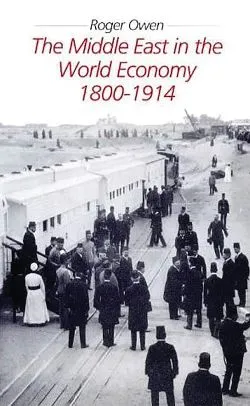
This book is honestly quite incredible. I don’t think it would be an exaggeration to say that books like this simply aren’t produced anymore. We can theorize why this might be: postmodern preference for cultural and minority histories, the preponderance of the political, and so on. But, Owen’s work is a nearly encyclopedic time machine. The fact that it manages to include so much with such brevity is an achievement in itself.
The subject of the book is described pretty well by the title: Owen examines the Middle East–defined here as Anatolia, greater Syria (i.e. the Levant), Egypt, and Iraq–through the lens of production, distribution, and circulation of goods. All of the important components are here: tables on commodity production, involved discussions of tax and land policy, descriptions of global trade, narratives about nascent industry, and so on.
This might sound dull, but it’s really quite interesting. I contend that the world is pretty damned difficult to understand without being able to make sense of its economic base, and the story being told here is really important. The through-line of the narrative (in my reading) is that Middle East provinces were heavily mismanaged by Ottoman authorities, which European powers used to their advantage. They fostered an intense dependence, culminating in the direct colonization of Egypt in 1882 and (not part of this narrative) the rest of the Middle East after the First World War.
Owen begins the book with a snapshot of the Middle East economy in 1800. This region of the world–like everywhere else–was essentially agrarian, and cereal production dominated. Still, other commodities like cotton, silk, and coffee were produced. For the most part, the many regions of the Middle East were self-sufficient. That is, they produced enough food to feed their populations. There was only one major exception: Mount Lebanon, which largely grew mulberries to feed the important and rich silk industry.
Owen pushes back against the idea that the Middle East economy was “stagnant” or “in decline,” although it did have serious problems, largely due to Ottoman tax policies. The Ottomans took a “tithe” in kind. Essentially, agricultural producers gave a portion of whatever they produced to Ottoman tax collectors. But, the Ottomans also demanded payment in currency, which encouraged Middle Eastern peasants to cultivate cash crops to be sold on the market, allowing them to fulfill their obligations to the Porte. Unfortunately, the mismanagement of these revenues caused the Porte (and Egypt) to become heavily indebted, as they took out large loans from Europeans–especially Britain, France, and Germany–to fulfill their own obligations, primarily military. By mid-century, the cost of servicing the debt outpaced other expenditures. Egypt and the Porte both went bankrupt and sought to be bailed out. Unsurprisingly, European capitalists used this to direct Middle Eastern finances as they wished. The Middle East really has not–to this day–broken out of the vicious cycle, even with decolonization.
Owen is honest about the difficulty of economic sources. Neither the Ottoman nor the Porte kept records on population, the costs of goods, or even trade. Many of the sources are European consuls, administrators, and businessmen making assumptions. This is especially true with the Mesopotamian provinces, which had large nomadic and semi-nomadic populations, as well as groups in the marshes who effectively evaded state supervision. Fortunately for us, Owen approaches his sources with a healthy skepticism and tries to triangulate information wherever possible. When the information is not there, he tells us so. He is clear about his own methods, which gives me much more trust in him.
Totally unrelated to the central argument, but the segments on the silk industry–largely in the chapters on greater Syria–absolutely fascinated me. I had no idea how silk was produced and, now that I do, it’s almost obvious why silk production collapsed in Lebanon. In addition, his discussion of Syrian/Lebanese migration helped illuminate why they have become such recognized merchants around the world. The segments on industry–appended near the end of each chapter–also interested me. I didn’t realize that Egypt, in the early 19th century, developed a small but abortive network of factories. Most of the industry covered is small-scale: these are not factories in the European sense, but small workshops almost entirely of less then ten men (and >80% less than five).
This book won’t be for everybody–it’s dense, slow-going, and packed–but I found it illuminating.